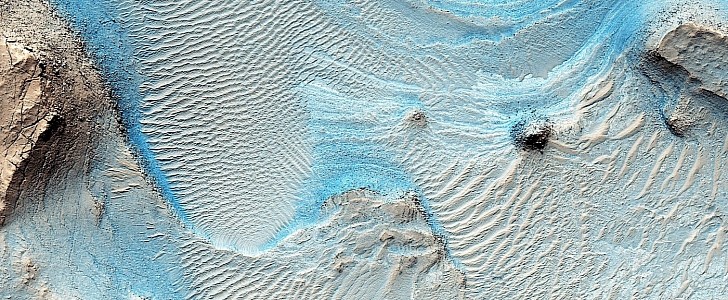Because of the tint the neighboring planet seems to have in the images we keep getting, we humans generally associate the very notion of Mars with the color red, or its copper or rust derivatives.
The place is reddish not only in images, but in real life as well. That’s owed to the iron oxide the planet seems to have all over its surface, the product of atmospheric elements interfering over the eons with the iron there.
Over time, seeing the same color over and over again tends to get old, and people, especially those looking at snapshots of Mars for a living, grow tired of that. That’s why, from time to time, one of the main photographic gear we have on location, the HiRISE camera, sends back something different.
Using the camera’s filters, scientists are able to change the color of the Martian surface, an action that is not necessarily dictated by boredom, but by the need to see the planet’s features better.
The blue-ish image we have here was captured by HiRISE back in 2016, from an altitude of 283 km (176 miles). It shows a small portion of the Nili Fossae, a series of concentric grabens (depressed blocks of the planet’s crust) in the Syrtis Major quadrangle.
Because this is an area showing layered bedrock, geologists had it pictured in light tones of blue, to better reveal horizontal striations in the sediment of the floor of this particular canyon. Over them sit “much younger ripples made up of dust and other wind blown sediments,” fractured rock on the canyon walls, and a floor littered with boulders.
The image helped geologists understand that this particular canyon was not chewed on Mars by water erosion, but is the result of faulting.
Once it was shaped in such a way as to contain water, the life-giving substance probably made its way here as well, sometime long ago in the planet’s past. That was deduced thanks to the detection of clay minerals that form in the presence of water.
Coloring the Martian surface by means of hardware in this particular region also helps us get a better understanding of how the Martian environment changed over the eons.
Because of the abundance of things it can teach us, NASA and the University of Arizona, who run the HiRISE, say this particular location is a solid candidate for a future robotic mission “that could traverse across these layers and make measurements that could be used to unravel a part of the early history of Mars.”
Over time, seeing the same color over and over again tends to get old, and people, especially those looking at snapshots of Mars for a living, grow tired of that. That’s why, from time to time, one of the main photographic gear we have on location, the HiRISE camera, sends back something different.
Using the camera’s filters, scientists are able to change the color of the Martian surface, an action that is not necessarily dictated by boredom, but by the need to see the planet’s features better.
The blue-ish image we have here was captured by HiRISE back in 2016, from an altitude of 283 km (176 miles). It shows a small portion of the Nili Fossae, a series of concentric grabens (depressed blocks of the planet’s crust) in the Syrtis Major quadrangle.
Because this is an area showing layered bedrock, geologists had it pictured in light tones of blue, to better reveal horizontal striations in the sediment of the floor of this particular canyon. Over them sit “much younger ripples made up of dust and other wind blown sediments,” fractured rock on the canyon walls, and a floor littered with boulders.
The image helped geologists understand that this particular canyon was not chewed on Mars by water erosion, but is the result of faulting.
Once it was shaped in such a way as to contain water, the life-giving substance probably made its way here as well, sometime long ago in the planet’s past. That was deduced thanks to the detection of clay minerals that form in the presence of water.
Coloring the Martian surface by means of hardware in this particular region also helps us get a better understanding of how the Martian environment changed over the eons.
Because of the abundance of things it can teach us, NASA and the University of Arizona, who run the HiRISE, say this particular location is a solid candidate for a future robotic mission “that could traverse across these layers and make measurements that could be used to unravel a part of the early history of Mars.”






